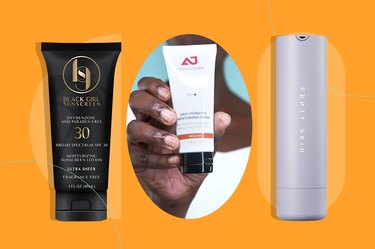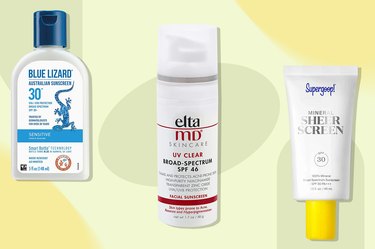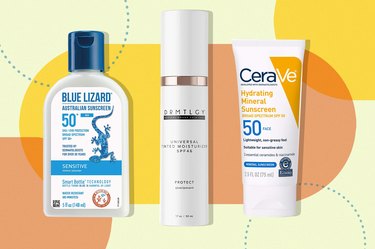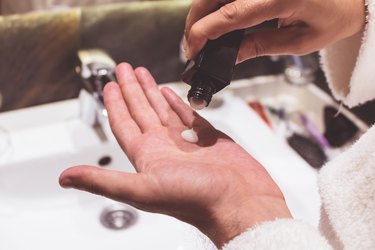
You know you're supposed to buckle your seat belt before driving. But there's one other important health and safety step you probably never think to do, and it's worth adding to your list.
It's wearing sunscreen. "Car windows can be a significant source of sun exposure for many people, especially if you spend a lot of time driving," explains Hyemin Pomerantz, MD, a board-certified dermatologist with Viva Skin Dermatology and Aesthetics in Wellesley, Massachussetts.
Video of the Day
Video of the Day
The same is also true for windows on airplanes, buses and trains, according to the Skin Cancer Foundation.
Why You Should Wear Sunscreen in the Car
Chances are, a long drive doesn't give you a tan the way a day on the beach might. But the sun exposure you are getting in the car can still harm your skin, experts say.
That's because the sun emits two kinds of ultraviolet (UV) rays: There are long UVA rays that can cause wrinkles and premature aging, and short UVB rays that can make your skin burn. The glass on your windows or windshield is pretty effective at blocking UVB rays (which is why you don't end up cherry red after some time in the car). But it's less effective at blocking UVA rays, Dr. Pomerantz says.
And even though you can see the effects of UVB rays much faster than UVA ones, both can damage the DNA of your skin cells and increase the risk for skin cancer, according to the Skin Cancer Foundation.
That's especially true for side windows. While front windshields can filter out around 96 percent of UVA, one July 2016 JAMA Ophthalmology study found that side windows only block around 71 percent of UVA rays.
As a result, "sun damage can predominantly affect the left side of the face and the left arm," says Dr. Pomerantz.
In fact, the increased UV ray exposure to drivers' left sides seems to partially account for higher rates of left-sided skin cancers and eye cataracts, the JAMA study notes.
When and How to Apply Sunscreen Before Driving
The easiest way to protect yourself from the UV rays penetrating your windshield and windows? You guessed it: Slather on some sunscreen before getting in the car or another vehicle. Unlike your window glass, a broad-spectrum sunscreen will filter out both UVA and UVB rays, offering protection against skin cancer. (Try one of these dermatologist-approved picks.)
Even though your left side bears the brunt of risk, there's no harm in giving your skin the benefit of full coverage. "I recommend putting it on all exposed areas, including the face, neck, chest, shoulders and arms," Dr. Pomerantz says. Don't forget the backs of your hands, too, and consider swiping on an SPF lip balm as well.
If it's a chemical sunscreen, try to apply it 10 to 20 minutes before getting into the car if you can, to give the sunscreen some time to settle in. Mineral sunscreens, on the other hand, are effective almost immediately after applying because they create a physical barrier against UV rays. (If you're not sure, simply follow the directions on the bottle.)
Just don't keep your sunscreen in the car. Tempting though it might be to store that bottle or tube in the glove compartment, "the hot temperatures can compromise the sunscreen's protective properties," Dr. Pomerantz warns.
Other Ways to Reduce Your Sun Exposure in the Car
Sunscreen isn't your only option for safeguarding your skin while you drive. "Wearing protective clothing would also be helpful," Dr. Pomerantz says. A long-sleeved shirt (or sun-protective shirt) will protect the skin on your arm, while a wide-brimmed hat and sunglasses with UV protection will shield your face.
You can also wear gloves with UPF protection, such as the Gannett UV Gloves UPF 50+ from Coolibar ($34).
If you want to get really serious, the Skin Cancer Foundation recommends installing transparent UV-blocking window film for added protection. They can be highly effective: UV coatings may block up to 87 percent of UV rays, found an older February 2004 study in the Journal of Long-Term Effects of Medical Implants.
The downsides? The coatings typically need to be professionally installed. Plus, "states have different rules for who can get their windows tinted and how dark the tint can be," Dr. Pomerantz says. So they may not be the best choice for everyone.
Sun shades like the Munchkin Brica Sun Safety Car Window Roller Shade ($15.49, Amazon), that you hang on your window, are another option. But because they're not transparent, they're a better option for passenger windows than the driver's side window.
The Bottom Line
Most of us get more sun exposure than we think while we're driving. But the same measures you take to protect your skin outside — applying sunscreen and keeping skin covered — will help reduce your exposure in the car.
Was this article helpful?
150 Characters Max
0/150
Thank you for sharing!
Thank you for your feedback!
Is this an emergency? If you are experiencing serious medical symptoms, please see the National Library of Medicine’s list of signs you need emergency medical attention or call 911.





